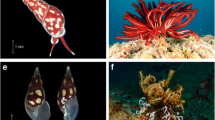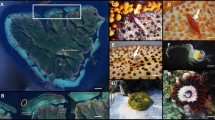Abstract
Symbiotic dinoflagellates, Symbiodinium microadriaticum (=zooxanthellae), may gain access to aposymbiotic hosts (i.e., those lacking zooxanthellae) by chemosensory attraction of the motile algae by the potential host or via an “intermediate” host. Laboratory experiments showed that motile zooxanthellae were attracted to intact aposymbiotic host animals, but not to starved symbiotic hosts. Fed symbiotic hosts and brine shrimp (Artemia sp.) nauplii also attracted motile zooxanthellae. The attraction of these zooxanthellae was directly correlated with nitrogen levels in the seawater surrounding the hosts; thus ammonia and possibly nitrate could be atractants. Brine shrimp nauplii, acting as “intermediate” hosts actively ingested both motile and non-motile zooxanthellae. the ingested zooxanthellae tended to remain morphologically unaltered during and after passage through the gut of the brine shrimp. Capture and ingestion of brine shrimp containing zooxanthellae by aposymbiotic scyphistomae of the jellyfish Cassiopeia xamachana led to infection of the scyphistomae with zooxanthellae. Zooxanthellae isolated from 17 different species of coelenterates and molluscs could be transferred via brine shrimp to the endodermal cells of the scyphistomae. However only 10 of these isolates persisted to establish a permanent association with C. xamachana. Scyphistomae in suspensions of motile zooxanthellae responded by a classical coelenterate feeding response, which may facilitate ingestion of the potential symbionts and establishment of a symbiosis.
Similar content being viewed by others
Literature cited
Abe, N.: Post-larval development of the coral Fungia aciniformis var. palawensis Doderlein. Palao trop. biol. Stn Stud. 1, 73–93 (1937)
Adler, J.: A method for measuring chemotaxis and use of the method to determine optimum conditions for chemotaxis by Escherichia coli. J. gen. Microbiol. 74, 77–91 (1973)
Atoda, K.: The larva and postlarval development of some reef-building corals I. Pocillopora damacornis cespitosa (Dana). Sci. Rep. Tôhoku Univ. 18, 24–47 (1947a)
Atoda, K.: The larva and postlarval development of some reef-building corals II. Stylophora pistillata (Esper). Sci. Rep. Tôhoku Univ. 18, 48–64 (1947b)
Atoda, K.: The larva and postlarval development of the reef-building corals III. Acropora bruggemanni. J. Morph. 89, 1–13 (1951a)
Atoda, K.: The larva and postlarval development of the reef-building corals IV. Galaxea aspera Quelch. J. Morph. 89, 17–30 (1951b)
Atoda, K.: The larva and postlarval development of some reef-building corals V. Seriatopora hystrix Dana. Sci. Rep. Tôhoku Univ. (Ser. 4) 19, 33–39 (1951c)
Atoda, K.: Post larval development of the sea anemone, Anthopleura sp. Sci. Rep. Tôhoku Univ. (Ser. 4) 20, 274–288 (1954)
Bigelow, R. P.: The anatomy and development of Cassiopea xamachana. Mem. Boston Soc. nat. Hist. 5, 191–236 (1904)
Cates, N. and J. J. A. McLaughlin: Differences of ammonia metabolism in symbiotic and aposymbiotic Condylactis and Cassiopea spp. J. exp. mar. Biol. Ecol. 21, 1–5 (1976)
Colley, C. J. and R. K. Trench: Selectivity in phagocytosis and persistence of symbiotic algae in the scyphistomae stage of the jellyfish Cassiopeia xamachana. Proc. R. Soc. (Ser. B) 219, 61–82 (1983)
David, C. N.: A quantitative method for maceration of Hydra tissue. Wilhelm Roux Arch. EntwMech. Org. 171, 259–268 (1973)
D'Elia, C. F., S. L. Domotor and K. L. Webb: Nutrient uptake kinetics of freshly isolated zooxanthellae. Mar. Biol. 75, 157–167 (1983)
Duerden, J. E.: West Indian madreporarean polyps. Mem. natn. Acad. Sci. 7, 403–597 (1902)
Edmundson, E. H.: Growth of Hawaiian corals. Bull. Bernice P. Bishop Mus. 58, 1–38 (1929)
Epp, R. W. and W. M. Lewis, Jr.: Photosynthesis in copepods. Science, N.Y. 214, 1349–1350 (1981)
Eppley, R. W.: Nitrate uptake. In: Handbook of phycological methods. Vol. 2. pp 401–411. Ed. by J. A. Hellebust and J. S. Craigie. Cambridge: Cambridge University Press 1978
Fankboner, P. V. and R. E. Reid: Mass expulsion of zooxanthellae by heat-stressed corals: a source of food for giant clams? Experientia 37, 251–252 (1981)
Faure, C.: Étude des phenomenes de reproduction chez Aglaophenia pluma (L.). Cah. Biol. mar. 1, 185–204 (1960)
Fitt, W. K.: Chemosensory response of the symbiotic dinoflagellate Symbiodinium microadriaticum J. Phycol. (In press). (1984)
Fitt, W. K., S. S. Chang and R. K. Trench: Motility patterns of different strains of the symbiotic dinoflagellate Symbiodinium (=Gymnodinium) microadriaticum Freudenthal in culture. Bull. mar. Sci. 31, 436–443 (1981)
Fitt, W. K., C. R. Fisher and R. K. Trench: Larval biology of tridacnid clams. Aquaculture, Amsterdam (In press). (1984)
Fitt, W. K. and R. K. Trench. Spawning, development, and acquisition of “zooxanthellae” by Tridacna squamosa (Mollusca, Bivalvia). Biol. Bull. mar. biol. Lab., Woods Hole 161, 213–235 (1981)
Fitt, W. K. and R. K. Trench: The relation of diel patterns of cell division to diel patterns of motility in the symbiotic dinoflagellate Symbiodinium microadriaticum freudenthal in culture. New Phytol. 94, 421–432 (1983a)
Fitt, W. K. and R. K. Trench: Endocytosis of the symbiotic dinoflagellate Symbiodinium microadriaticum Freudenthal by endodern cells of the scyphistomae of Cassiopeia xamachana and resistance to host digestion. J. Cell Sci. 64, 195–212 (1983b)
Fraser, E. A.: Observations on the life-history and development of the hydroid Myrionema amboinense. Scient. Rep. Gt Barrier Reef Exped. 3, 135–144 (1931)
Freudenthal, H. D.: Symbiodinium gen. nov. and Symbiodinium microadriaticum sp. nov., a zooxanthella: taxonomy, life cycle, and morphology. J. Protozool. 9, 45–52 (1962)
Gibor, A.: Some ecological relationships between phyto- and zooplankton. Biol. Bull. mar. biol. Lab., Woods Hole 111, 230–234 (1956)
Gohar, H. A. F.: Studies on the Xeniidae of the Red Sea, their ecology, physiology, taxonomy and phylogeny. Publs mar. biol. Stn Ghardaqa 2, 24–118 (1940)
Gohar, H. A. F. and A. M. Eisawy: The development of Cassiopea andromeda (Scyphomedusae). Publs mar. biol. Stn Ghardaqa 11, 148–190 (1960)
Goreau, T. F.: Mass expulsion of zooxanthellae from Jamaican reef communities after Hurricane Flora. Science, N.Y. 145, 383–386 (1964)
Jaap, W. C.: Observations on zooxanthellae expulsion at middle Sambo Reef, Florida Keys. Bull. mar. Sci. 29, 414–422 (1979)
Jameson, S. C.: Early life history of the giant clams Tridacna crocea Lamarck, Tridacna maxima (Poding) and Hippopus hippopus (Linnaeus). Pacif. Sci. 30, 219–233 (1976)
Kawaguti, S.: On the physiology of reef corals. V. Tropisms of coral planulae, considered as a factor of distribution of the reefs. Palao trop. biol. Stn Stud. 2, 319–328 (1941)
Kawaguti, S.: Observations of the heart shell, Corculum cardissa (L.), and its associated zooxanthellae. Pacif. Sci. 4, 43–49 (1950)
Kinzie, R. A., III: Experimental infection of aposymbiotic gorgonian polyps with zooxanthellae. J. exp. mar. Biol. Ecol. 15, 335–345 (1974)
Kojis, B. L. and N. J. Quinn: Aspects of sexual reproduction and larval development in the shallow water hermatypic coral, Goniastrea australensis (Edwards and Haime, 1857). Bull. mar. Sci. 31, 558–573 (1981a)
Kojis, B. L. and N. J. Quinn: Reproductive strategies in four species of Porites (Scleractinia). Proc. 4th int. Symp coral Reefs 2, 145–151 (1981b). (Ed. by E. D. Gomez et al. Quezon City: Marine Sciences Centre of the Philippines)
Kojis, B. L. and N. J. Quinn: Reproductive ecology of two favid corals (Coelenterata: Scleractinia). Mar. Ecol. Prog. Ser. 8, 251–255 (1982)
Krupp, D.: Sexual reproduction and early development of the solitary coral, Fungia scutaria (Anthozoa: Scleractinia). Coral Reefs 2, 159–164 (1983)
LaBarbera, M.: Larval and post larval development of the giant clams Tridacna maxima and Tridacna squamosa (Bivalvia: Tridacnidae). Malacologia 15, 69–79 (1975)
Liddicoat, M. I., S. Tibbits and E. Butler: The determination of ammonia in seawater. Limnol. Oceanogr. 20, 131–132 (1975)
Loeblich, A. R., III and J. L. Sherley: Observations on the theca of the motile phase of free-living and symbiotic isolates of Zooxanthella microadriatica (Freudenthal) comb. nov. J. mar. biol. Ass. U.K. 59, 195–205 (1979)
Ludwig, L. D.: Die Zooxanthellen bei Cassiopea andromeda Eschscholtz 1829 (Polyp-Stadium) und ihre Bedeutung für die Strobilation. Zool. Jb. (Abt. Anat. Ont. Tiere) 86, 238–277 (1969)
Mangan, J.: The entry of zooxanthellae into the ovary of Millipora and some particulars concerning the medusa. Q. Jl microse. Sci. 33, 697–709 (1909)
Marshall, S. and T. A. Stephenson: The feeding of reef animals. I. The corals. Scient. Rep. Gt Barrier Reef Exped. 3, 219–245 (1933)
McLaughlin, J. J. A. and P. A. Zahl: Endozoic algae. In: Symbiosis. Vol. 1, pp 257–297. Ed. by S. M. Henry. New York: Academic Press 1966
McMurrich, J.: Contributions on the morphology of the Actinozoa II. On the development of the Hexactiniae. J. Morph. 4, 303–330 (1891)
Muscatine, L.: Nutrition of corals. In: Biology and geology of coral reefs, Vol. II. pp 77–115. Ed. by O. A. Jones and R. Endean. New York: Academic Press 1973
Muscatine, L. and C. F. D'Elia: The uptake, retention, and release of ammonium by reef corals. Limnol. Oceanogr. 23, 225–234 (1978)
Muscatine, L., H. Masuda and R. Burnap: Ammonium uptake by symbiotic and aposymbiotic reef corals. Bull. mar. Sci. 29, 572–575 (1979)
Pearse, V. B.: Modification of sea anemone behavior by symbiotic zooxanthellae: phototaxis. Biol. Bull. mar. biol. Lab., Woods Hole 147, 630–640 (1974)
Porter, K. G.: Enhancement of algal growth and productivity by grazing zooplankton. Science N.Y. 192, 1332–1333 (1976)
Provasoli, L., T. Yamasu and I. Manton: Experiments on the resynthesis of symbiosis in Convoluta roscoffensis with different flagellate cultures. J. mar. biol. Ass. U.K. 48, 465–479 (1968)
Reimer, A. A.: Observation on the relationships between several species of tropical zoanthids (Zoanthidae, Coelenterata) and their zooxanthellae. J. exp. mar. Biol. Ecol. 7, 207–214 (1971)
Siebert, A. E.: A description of the embryology, larval development, and feeding of the sea anemones Anthopleura elegantissima and A. xanthogramica. Can. J. Zool. 52, 1383–1388 (1974)
Steele, R. D.: Stages in the life history of a symbiotic zooxanthella in pellets extruded by its host Aiptasia tagetes (Duch. and Mich.) (Coelenterata, Anthozoa). Biol. Bull. mar. biol. Lab., Woods Hole 149, 590–600 (1975)
Steele, R. D.: Light intensity as a factor int he regulation of the density of symbiotic zooxanthellae in Aiptasia tagetes (Coelenterata, Anthozoa). J. Zool., Lond. 179, 387–405 (1976)
Steele, R. D.: The significance of zooxanthella-containing pellets extruded by sea anemones. Bull. mar. Sci. 27, 591–594 (1977)
Stephenson, T. A.: Development and the formation of colonies in Pocillopora and Porites. I. Scient. Rep. Gt Barrier Reef Exped. 3, 247–272 (1934)
Sugiura, Y.: On the life-history of rhizostome medusae. I. mastigias papua L. Agassiz. Annotnes zool. jap. 36, 194–202 (1963)
Sugiura, Y.: On the life-history of rhizostome medusae. II. Indispensability of zooxanthellae for strobilation in Mastigas papua. Embryologia 8, 223–233 (1964)
Szmant-Froelich, A., P. Yevich and M. E. Q. Pilson: Gametogenesis and early development of the temperate coral Astrangia danae (Anthozoa: Scleractinia). Biol. Bull. mar. biol. Lab., Woods Hole 158, 257–269 (1980)
Taylor, D. L.: The cellular interactions of algal-invertebrate symbiosis. Adv. mar. Biol. 11, 1–56 (1973)
Taylor, F. J. R.: Possible free-living Symbiodinium microadriaticum (Dinophyceae) in tide pools in Southern Thailand. In: Endocytobiology, Vol. II. pp 1009–1014. Ed. H. E. A. Schenk and W. Schwemmler. Berlin: de Gruyter 1983
Theodor, J.: Contribution a l'étude des gorgones (VIII): Eunicella stricta aphyta sous-espèce nouvelle sans zooxanthelles, proche d'une espèce normalement infestée par ces algues. Vie Milieu 20, 635–638 (1969)
Trench, R. K.: Nutritional potentials in Zoanthus sociathus (Coelenterata, Anthozoa). Helgoländer wiss. Meeresunters. 26, 174–216 (1974)
Trench, R. K.: The cell biology of plant-animal symbiosis. A. Rev. Pl. Physiol. 30, 485–532 (1979)
Trench, R. K., N. J. Colley and W. K. Fitt: Recognition phenomena in symbioses between marine invertebrates and “zooxanthelae”; uptake, sequestration and persistence. Ber. dt. bot. Ges. 94, 568–577 (1981)
Wilkerson, F. P. and L. Muscatine: Uptake and assimilation of dissolved inorganic nitrogen by a symbiotic sea anemone. Proc. R. Soc. (In press). (1984)
Author information
Authors and Affiliations
Additional information
Communicated by N. D. Holland, La Jolla
Rights and permissions
About this article
Cite this article
Fitt, W.K. The role of chemosensory behavior of Symbiodinium microadriaticum, intermediate hosts, and host behavior in the infection of coelenterates and molluscs with zooxanthellae. Mar. Biol. 81, 9–17 (1984). https://doi.org/10.1007/BF00397620
Accepted:
Issue Date:
DOI: https://doi.org/10.1007/BF00397620




